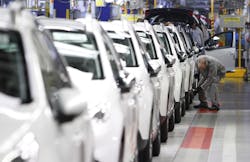On a recent trip to Detroit, Alliance for American Manufacturing (AAM) President Scott Paul said that instead of the city having to deal with a myriad of crises, such as keeping the water on, it should instead be talking about “building on America's strengths and Detroit's strengths.”
The first order of business he sees is for the government to have the “right policies" for the manufacturing sector.
“This isn't about rebuilding manufacturing the way it was in America, but rather about how we can restore American manufacturing leadership in this century.”
He suggests, in an Huffington Post article, that elected officials need to do the following:
- Cut the trade deficit in goods with China in half over the next three years. This means more exports, and fewer subsidized imports from China and Japan that dislocate workers in places like Detroit. It does us little good to double exports, as President Obama stumped for during his re-election campaign, if imports rise at an even greater rate.
- Restore the balance of power between the industrial park and Wall Street. Financial deregulation in the late 1990s made the financial sector the master of manufacturing. That, along with the creation of CDOs and other get-rich-quick "innovations," was a huge mistake. Ensure that our small- and mid-sized manufacturers have access to affordable, patient capital.
- Rebuild the connection between innovation and production. Our tax dollars fund research that helps create amazing products - that are made overseas and sold back to us. We should insist that federally supported R&D is channeled into the design, engineering, and productions of goods in America. Congress should fund the plan proposed by the Obama administration to create a network of national innovation institutes.
- Adopt policies to boost demand. That means infrastructure investment and tax policies geared toward higher levels of production and consumption of domestic goods. Even with automation and productivity, higher demand means we'll be supporting more manufacturing jobs. Don't allow Wall Street and retailers to hijack corporate tax reform when only manufacturers face real global competition.
- Scrap the "strong dollar" policy that helps U.S. businessmen find cheaper hotel rooms overseas in favor of a competitively valued dollar that will boost our exports. The Institute for International Economics estimates that the dollar is overvalued, while China's and Japan's currencies are undervalued. We should insist those governments end policies that deliberately lower the value of their currencies.
- Adopt smart energy policies that will position the U.S. as the global leader in renewable energy equipment manufacturing and boost our emerging energy cost advantage. Exporting loads of domestic natural gas to countries that subsidize their own industries makes little sense.
- Encourage small-scale manufacturers to embrace "urban manufacturing," the "cloud," and additive manufacturing. This will localize manufacturing, reduce imports, and establish a new generation of makers.
- Rebuild our system of vocational education. Creating a seamless system of training from high school, to community college, and on to the factory floor for a new generation of manufacturing workers will boost American manufacturing's competitiveness and provide a viable career path for millions of Americans.
About the Author

Adrienne Selko
Senior Editor - MH&L, IW, & EHS Today
Adrienne Selko has written about many topics over the 17 years she has been with Endeavor Business Media and currently focuses on workforce development strategies. Previously Adrienne was in corporate communications at a medical manufacturing company as well as a large regional bank.
She is the author of Do I Have to Wear Garlic Around My Neck? which made the Cleveland Plain Dealer's best sellers list. She is a senior editor at Material Handling & Logistics, EHS Today, and IndustryWeek.
Editorial Mission Statement:
Manufacturing is the enviable position of creating products, processes, and policies that solve the world’s problems. When the industry stepped up to manufacture what was necessary to combat the pandemic, it revealed its true nature. My goal is to showcase the sector’s ability to address a broad range of workforce issues including technology, training, diversity & inclusion, with a goal of enticing future generations to join this amazing sector.
Why I Find Manufacturing Interesting:
On my first day working for a company that made medical equipment such as MRIs, I toured the plant floor. On every wall was a photo of a person, mostly children. I asked my supervisor why this was the case and he said that the work we do at this company has saved these people’s lives. “We never forget how important our work is and everyone’s contribution to that.” From that moment on I was hooked on manufacturing.
I have talked with many people in this field who have transformed their own career development to assist others. For example, companies are hiring those with disabilities, those previously incarcerated, and other talent pools that have been underutilized. I have talked with leaders who have brought out the best in their workforce, as well as employees doing their best work while doing good for the world.
